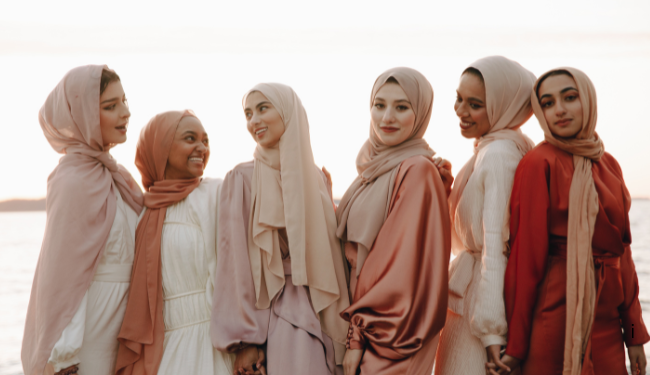In recent years, the hijab has transcended its traditional cultural and religious boundaries, emerging as a prominent symbol in the global fashion industry. This piece of fabric, worn by millions of Muslim women as a sign of modesty and faith, has now found a place on international fashion runways, in mainstream retail stores, and within the broader conversations around inclusivity in fashion.
This article explores how hijab fashion has become a powerful tool for bridging cultures and promoting a more inclusive global fashion narrative.
The Historical Context of the Hijab
The hijab, traditionally a headscarf worn by Muslim women to cover their hair and often their neck and chest, is rooted in the Islamic principle of modesty. While the specifics can vary greatly depending on geographical, cultural, and individual factors, the core idea remains the same—to maintain modesty as prescribed by religious texts.
Historically, the hijab was not just a religious symbol but also an item influenced by local cultures, which is why styles, colors, and fabrics vary significantly from one Muslim-majority country to another. Among the popular variations today are jersey hijabs, known for their soft, stretchable fabric that ensures comfort and ease of styling. These hijabs are particularly favored for their practicality and versatility, appealing to both the fashion-conscious and those seeking straightforward, fuss-free options.
Rise of Hijab Fashion in the Global Market
The last two decades have witnessed a remarkable transformation in how the hijab is viewed in the fashion industry. Initially, fashion for Muslim women was largely overlooked by mainstream brands.
However, the economic potential of the Muslim fashion market, which is projected to grow exponentially, has spurred brands and designers to explore this niche yet lucrative segment.
Luxury fashion brands like Dolce & Gabbana, Nike, and Uniqlo have started offering hijab collections, which not only acknowledges the garment’s market potential but also its cultural significance in a globalized world.
Bridging Cultures Through Hijab Fashion
- Fashion Shows and International Platforms: Hijab-wearing models have graced international fashion shows, bringing the traditional Islamic headscarf into the global fashion spotlight. This representation helps demystify the hijab, presenting it as an item of fashion and personal expression rather than solely a symbol of religious obligation.
- Collaborations and Cross-Cultural Exchanges: Collaborations between Western designers and Middle Eastern fashion houses have been pivotal in blending cultural aesthetics. These collaborations are often a celebration of diversity, showcasing how fashion can serve as a bridge between differing cultural identities and values.
- Social Media and Influencer Impact: Social media has played a crucial role in the globalization of hijab fashion. Hijab-wearing influencers from various parts of the world share their personal style and narratives online, reaching global audiences and shaping perceptions about what it means to be a modern, fashion-forward Muslim woman.
Challenges in the Path of Globalization
Despite the positive strides, the path of integrating hijab into global fashion is fraught with challenges. Issues of cultural appropriation, the commodification of religious symbols, and the risk of diluting the hijab’s religious significance are topics of ongoing debate.
Moreover, there is a fine line between inclusive representation and tokenism that brands need to navigate carefully to ensure that their approaches to hijab fashion are respectful and genuine.
Economic Impact and Market Dynamics
The economic implications of hijab fashion are significant. The Muslim consumer market is burgeoning, with increasing demand for fashionable yet modest clothing options.
This demand drives innovation in textile technology, retail, and marketing strategies tailored to respect cultural sensitivities while appealing to a cosmopolitan clientele. For instance, the development of breathable, lightweight fabrics suitable for hijabs has become a new focus for textile manufacturers.
Educational Initiatives and Community Engagement
Cultural Sensitivity Workshops
As hijab fashion continues to make its way into the global arena, there’s a growing need for educational programs that promote a deeper understanding of its cultural and religious significance.
Workshops and seminars can be instrumental in educating those within the fashion industry—designers, marketers, and retail employees—about the nuances of modest fashion. These initiatives not only foster a respectful approach towards hijab-wearing consumers but also enhance the authenticity of the designs produced.
Community Collaborative Projects
Engaging directly with the communities that wear hijabs can lead to more meaningful fashion offerings. Fashion brands can collaborate with local hijab-wearing women to create collections that are culturally sensitive and stylistically appealing.
These projects not only ensure that the products meet the actual needs and preferences of Muslim women but also empower these communities by involving them directly in the creative process.
Future Trends and Innovations
Looking ahead, hijab fashion is set to become more integrated with technology, sustainability, and ethical fashion movements. Innovations such as eco-friendly hijabs and smart fabrics that adjust to environmental conditions are likely to become more prevalent.
Additionally, as the conversation around sustainability grows louder, more brands might turn to ethical ways of producing hijabs, ensuring fair trade practices and organic materials are used.
Conclusion
The globalization of hijab fashion exemplifies how a simple piece of clothing can become a powerful conduit for cultural exchange, economic opportunity, and social change. As the world becomes increasingly interconnected, fashion continues to play a crucial role in shaping and expressing new cultural identities. The journey of the hijab from a traditional religious symbol to a globally recognized fashion item is not just about the changing styles and fabrics but also about the stories of empowerment, identity, and diversity that it narrates. This evolution is a testament to the dynamic, transformative power of fashion as a universal language that bridges cultures and breaks barriers.







